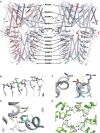TRPA1 rare variants in chronic neuropathic and nociplastic pain patients
- PMID: 37079850
- PMCID: PMC10443199
- DOI: 10.1097/j.pain.0000000000002905
TRPA1 rare variants in chronic neuropathic and nociplastic pain patients
Abstract
Missing aspects of the heritability of chronic neuropathic pain, as a complex adult-onset trait, may be hidden within rare variants with low effect on disease risk, unlikely to be resolved by a single-variant approach. To identify new risk genes, we performed a next-generation sequencing of 107 pain genes and collapsed the rare variants through gene-wise aggregation analysis. The optimal unified sequence kernel association test was applied to 169 patients with painful neuropathy, 223 patients with nociplastic pain (82 diagnosed with chronic widespread pain and 141 with fibromyalgia), and 216 healthy controls. Frequency and features of variants in TRPA1, which was the most significant gene, were further validated in 2 independent cohorts of 140 patients with chronic pain (90 with painful neuropathy and 50 with chronic widespread pain) and 34 with painless neuropathy. The effect of aminoacidic changes were modeled in silico according to physicochemical characteristics. TRPA1 was significantly enriched of rare variants which significantly discriminated chronic pain patients from healthy controls after Bonferroni correction (P = 6.7 × 10−4, ρ = 1), giving a risk of 4.8-fold higher based on the simple burden test (P = 0.0015, OR = 4.8). Among the 32 patients harboring TRPA1 variants, 24 (75%) were diagnosed with nociplastic pain, either fibromyalgia (12; 37.5%) or chronic widespread pain (12; 37.5%), whereas 8 (25%) with painful neuropathy. Irrespective of the clinical diagnosis, 12 patients (38%) complained of itch and 10 (31.3%) of cold-induced or cold-accentuated pain, mostly episodic. Our study widens the spectrum of channelopathy-related chronic pain disorders and contributes to bridging the gap between phenotype and targeted therapies based on patients' molecular profile.
Conflict of interest statement
The authors disclose no conflicts of interest.
This work was supported by funding from the Molecule-to-Man Pain Network, European Commission Multi-Center Collaborative Projects through the European Union's Horizon 2020 research and innovation program under grant agreement No. 721841, the PROPANE study of the European Union seventh framework programme under grant agreement No. 602273, and the Italian Ministry of Health (RRC).
Figures


References
-
- Alsaloum M, Higerd GP, Effraim PR, Waxman SG. Status of peripheral sodium channel blockers for non-addictive pain treatment. Nat Rev Neurol 2020;16:689–705. - PubMed
-
- Arnold LM, Bennett RM, Crofford LJ, Dean LE, Clauw DJ, Goldenberg DL, Fitzcharles MA, Paiva ES, Staud R, Sarzi-Puttini P, Buskila D, Macfarlane GJ. AAPT diagnostic criteria for fibromyalgia. J Pain 2019;20:611–28. - PubMed
-
- Betts MJ, Russell RB. Amino acid properties and consequences of substitutions. Bioinformatics for Geneticists. Edited by Michael R. Barnes and Ian C. Gray. John Wiley & Sons, 2003.
-
- Binder A, May D, Baron R, Maier C, Tölle TR, Treede RD, Berthele A, Faltraco F, Flor H, Gierthmühlen J, Haenisch S, Huge V, Magerl W, Maihöfner C, Richter H, Rolke R, Scherens A, Uçeyler N, Ufer M, Wasner G, Zhu J, Cascorbi I. Transient receptor potential channel polymorphisms are associated with the somatosensory function in neuropathic pain patients. PLoS One 2011;6:e17387. - PMC - PubMed
Publication types
MeSH terms
Substances
LinkOut - more resources
Full Text Sources
Medical
Research Materials
Miscellaneous

